
The list of expenses varies from breed to breed based upon genetic conditions, size and energy levels.
Some dogs require a lot of space to run around but won’t consume food a bag at a time.
Other breeds are large and routinely go through 50lb bags of food, but spend their day sleeping and are happy to live wherever their people live.
The following breeds are 12 examples of budget friendly dogs to own.
1. American/English Foxhounds
The American and English Foxhounds are closely related breeds and puppies can be found for relatively cheap upfront prices of around $50 and $25 (respectively).
Both breeds are wonderful with children and love the company of other dogs. You will not have to spend a lot of time or money finding entertaining things for these dogs to do. They will be very happy playing in the yard with your kids, or even with each other.
Additionally, neither breed has a particularly long lifespan at 10-13 years on average. They will consume more food than smaller dog breeds with an average adult weight of 65-75lbs, but are far from the type of dog that consumes a bag of food every other week.
Most importantly, neither breed has any well-documented genetic defects leading to extensive veterinary care.
Healthy, loving, and easy to please, foxhounds make wonderful pets. They are a good compromise between a big dog that costs an arm and a leg to feed, and a small designer breed, which often suffer from health problems.
Foxhounds need around 30 to 60 minutes of exercise per day, some of which can come in the form of running around the yard.
2. American Cocker Spaniel
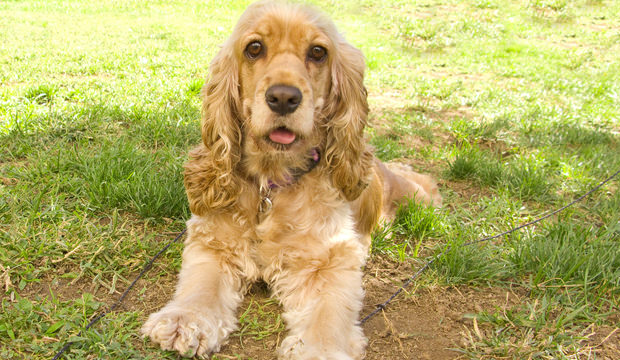
You should always get this type of dog from a reputable breeder or shelter, so that you know that the dog is healthy and has been well cared for prior to coming to live in your home.
While the typical spaniel lives approximately 12 to 15 years, their smaller size and leaner build means that these dogs require less food than other larger dogs.
This factor can offset some of the costs brought about by the longer lifespan.
Although this particular spaniel breed has longer hair that may require professional trimming, shedding is moderate so cleaning up after them won’t drain your pocketbook. You also get to show off your beautiful long-haired dog to your friends, who will all fall instantly in love!
The one downside to the breed is a history of ear infections, eye problems and hip dysplasia, which could lead to vet bills as the dog ages. Again, though, the lower cost of typical maintenance and care generally offsets these age-related health problems.
Hip dysplasia is usually caused by genetic factors, so you should ask your breeder whether the dog’s parents suffered from this condition. If the parents are unaffected, then the chances of your dog developing hip problems are lower.
3. Australian Terrier
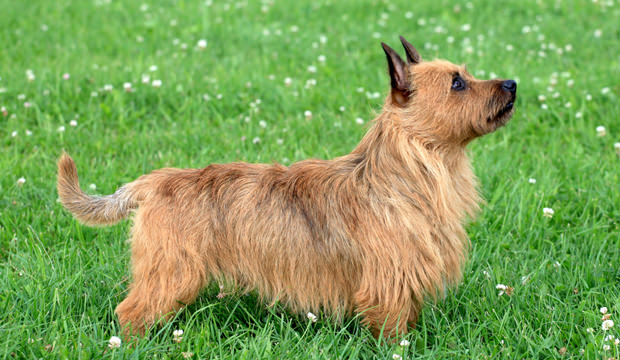
Compared to other small dog breeds, the Australian Terrier’s 12-14 year lifespan is not particularly long.
With medium length hair and only light shedding, the cost of cleaning up after and maintaining the coat on this terrier is minimal as well.
In fact, you should avoid washing this breed more than once a month, as the coat is capable of producing its own oils to help it stay clean and healthy.
One of a big benefit of owning a smaller dog is that you won’t need to spend hundreds each month on food. The Australian Terrier can be kept in a smaller home and will manage without a yard provided that you take it on a daily walk around the neighborhood. You can keep this dog in an apartment as it is quite small and not as active as some other breeds.
Best of all, the Australian Terrier is free of any major health concerns or hereditary diseases. Most vet bills consist of routine care or age-related problems that can occur in all older dogs.
4. Bolognese
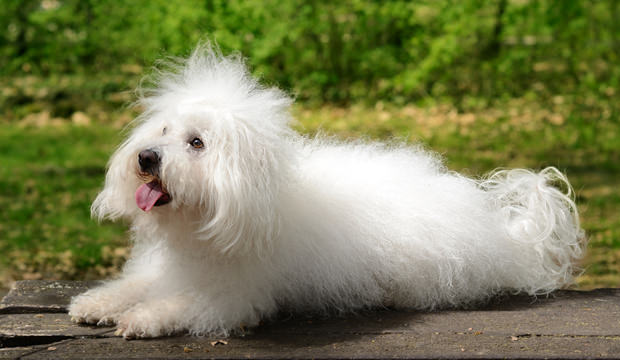
Bolognese dogs reach a full size of anywhere between 8 and 14lbs, making them ideal for those with smaller homes.
The Bolognese doesn’t require extensive training or exercise in order to live a healthy life.
It can be happily kept in an apartment, as long as you make sure it gets out for regular walks. With such a small body weight, a Bolognese won’t break the bank on food either.
In fact, given the small size and relatively low levels of activity of this dog, you should take care to avoid overfeeding. The biggest cost concern with the average Bolognese is grooming.
Its moderately long hair does clump up easily, so you’ll need a good brush to get through the knots. You must also be able to spare the time to brush their coat a few times each week.
Think of this time as quality bonding time that you spend with your dog! Most Bologneses are affectionate and enjoy being brushed. Despite the length of the Bolognese’s coat, they do not shed much, so it requires little cleaning to maintain a dog hair-free home.
5. Bichon Frise
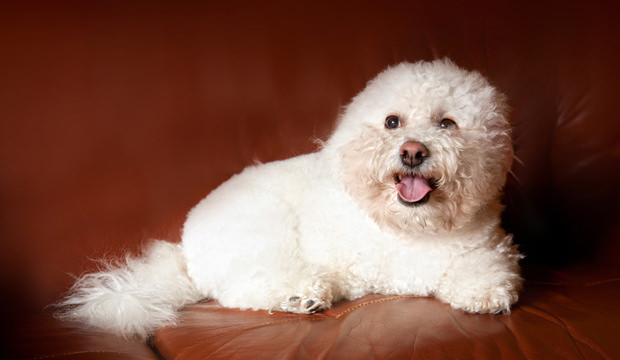
These adorable and affectionate little creatures do not make particularly high demands on their owners, and owning one should not put too much of a strain on your wallet.
Along with the Bolognese, the Bichon Frise is one of the smallest dog breeds available, which means you will need neither a large house, nor a huge fenced-in yard, nor 50lb bags of dog food just to survive from week to week with a Frise running around the house.
The Bichon Frise is generally well-behaved and won’t require extensive training or a lot of exercise time to maintain a happy mood. In fact, these dogs can even be somewhat lazy. If you are looking for a companion to curl up with you on cold winter evenings, you may have found your match.
The only expense to be concerned about with the Bichon Frise is maintaining its coat, which needs regular grooming. Many owners find that they are able to brush their Frise’s coat at home to keep it neat and tidy, rather than needing to take the dog to a professional groomer.
6. Pug
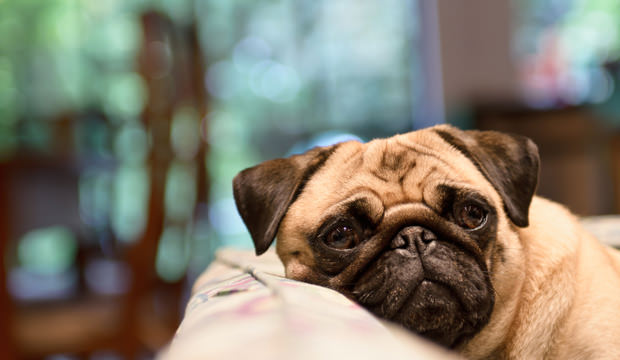
If you get your pug from a shelter rather than a puppy breeder, the upfront cost is likely to be much less.
You will also have the satisfaction of knowing that you are providing a loving home for a dog that really needs it.
Pugs generally tip the scales at a maximum of 18lbs and require very little training or space to run as they are a low energy breed.
You do not need a big yard, as even running around the house can be enough of a challenge for a Pug’s stubby little legs.
Grooming concerns are moderate. While the Pug has short hair, it does shed frequently. You need to be prepared to vacuum frequently, unless you don’t mind living with a little dog hair in your home.
The biggest financial concern with a pug is food. If your Pug’s weight isn’t managed, they will overeat, leading to potential health problems should they become overweight. Try to restrict your Pug’s food consumption to an amount that keeps their weight stable.
7. Puggle
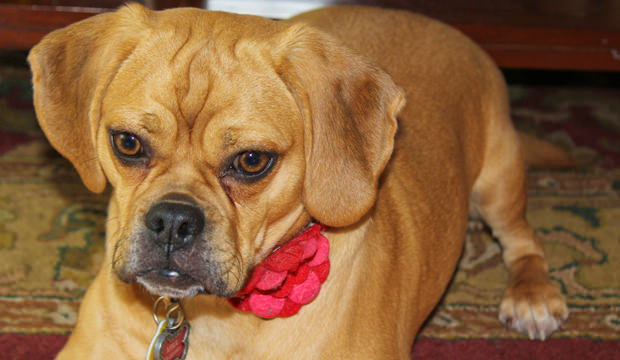
The Puggle is a mixed breed that comes from the cross-breeding of a Pug and a Beagle. They maintain many of the features of a Pug, such as the smaller size (15-25 lbs on average).
Puggles generally have no need for expansive homes and yards to play in.
Training and grooming are low with the Puggle as they are laid-back dogs with cheerful dispositions and short hair.
They generally get on very well with children and are content to be fussed over by every member of the family.
One potential area of expense could be on toys and exercise time. Although Puggles are generally classed as a low-energy dog, the Beagle in them does have a little bit of extra playfulness that needs to be burned off from time to time. It is nothing a brisk walk can’t eliminate, though.
Because Puggles are a newer breed, it is difficult to say whether they are particularly prone to health problems. Fortunately, neither Pugs nor Beagles are known for their ability to rack up huge medical bills, which bodes well for the healthfulness of their Puggle offspring.
8. Greyhound
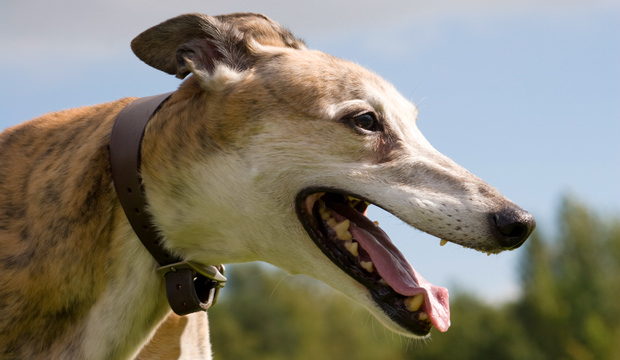
Thought larger than most dogs on the list at an average weight of 60-70lbs, the Greyhound is a slender dog that generally does not go through as much food as other larger breeds.
Additionally, for a larger breed dog, the need for space is pretty low. Greyhounds are well-known for having lower activity levels than some smaller breeds.
Yes, they can run very fast when they need to, but Greyhounds are built for speed, not stamina. They do not need to be running around all day to be happy.
As a result, training and exercise costs are generally relatively low for this breed. A good 20 minute walk every day or every other day is good enough for most Greyhounds. Their short coat keeps grooming costs down too.
However, there are concerns with skin sensitivities in some Greyhounds, so vet bills are a possibility. To keep your Greyhound’s skin healthy, wash him only with specially formulated doggy shampoo, which is designed to be more gentle on his skin than brands targeted at humans.
9. Bullmastiff
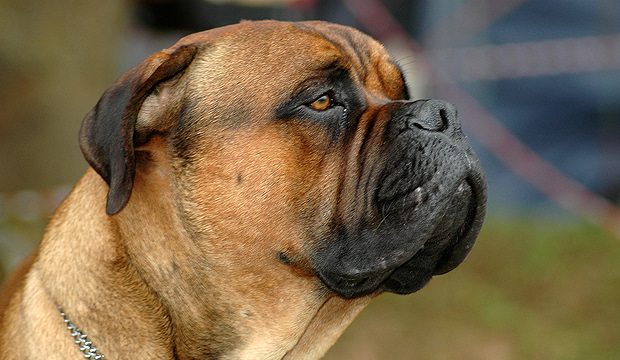
The Bullmastiff is the largest breed on the list and will require an investment in food as the average mastiff reaches 100 to 130lbs.
They are extremely low-key dogs that do not require much exercise, training or room to roam.
Additionally, the Bullmastiff has very short hair and does not shed frequently so maintaining a house with a mastiff isn’t a problem.
The biggest concern, aside from food, is the potential for hip and elbow dysplasia, as well as eye problems when they reach advanced ages. To maximize your chance of getting a healthy Bullmastiff dog, always ask the breeder about the health of the parents.
If you want to own a big dog but don’t have a huge home or several hours a day to put into training and exercising your dog, then the Bullmastiff could be one possible choice. Buying dried or canned dog food in bulk could help to keep food bills down to a manageable level. Once again, you should be careful not to overfeed this type of dog, as obesity can lead to expensive health problems.
10. Bulldog

Although the average bulldog can weigh between 40 and 50lbs, they maintain that weight in a small, compact frame that doesn’t require a big house or yard to live happily.
Training and grooming needs for Bulldogs are low compared to many other dog breeds.
With short hair and infrequent shedding it is easy to clean up after them too. Bulldogs are affectionate and loyal, making them easy to train.
Take your bulldog to the park a couple of times a week and let him snuffle around in the grass to keep him happy. One thing to watch out for is the Bulldog’s tendency to overheat in hot weather, so make sure he has a shady spot to lie down in.
The biggest concerns with Bulldogs are related to their health. First, those lovable wrinkles on their face do require cleaning on occasion to avoid infections and disease. Secondly, Bulldogs are extremely lazy but will overeat, so you’ll need to monitor their weight to ensure they don’t become overweight. If your Bulldog is starting to show signs of tubbiness, perhaps it is time to start limiting the number of treats he gets.
11. Beagle
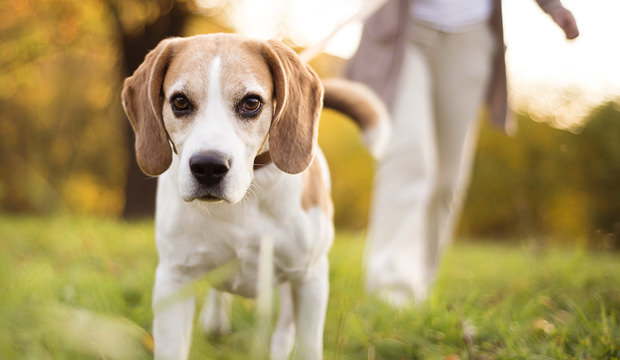
That being said, for an active outdoor dog it doesn’t require a great deal of space and can happily live in a moderately sized apartment.
Regular exercise and walks can help to make this kind of living arrangement easier.
Beagles won’t consume food by the 50lb bag, so food expenses are low. Make sure your beagle gets out for a walk every day to burn off some of the calories from his food, and he should stay happy and healthy for many years to come.
Beagles frequently clean themselves on a level few other dogs do, and their short hair and light shedding make cleaning up after them easy.
Beagles are smart dogs, but if you are looking for those hunting instincts to shine through, then they will need some professional training. Basic levels of training can be achieved relatively quickly, as Beagles are quick to pick up on new ideas and modify their behavior to please you.
These dogs are loyal and dependable, but watch out for them getting into mischief by sniffing out foods they are not supposed to have. If your beagle misbehaves, take him for a run to burn off some excess energy.
12. Chihuahua
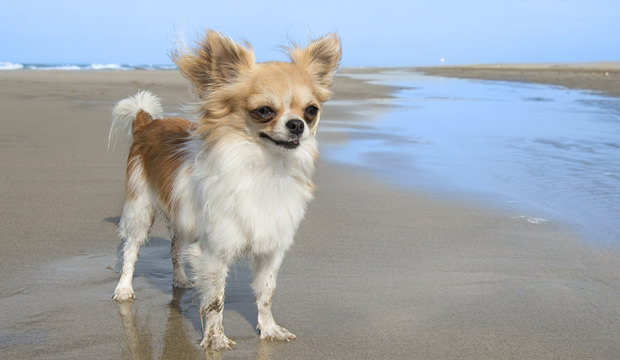
You could live in the tiniest studio apartment available and still have a happy Chihuahua.
These dogs tip the scales at an average of 6 to 9lbs, meaning food consumption is extremely low.
Chihuahuas also have lower energy levels than most dogs, making them ideal for city apartment living. They are curious and will run around the house on their tiny legs, but they quickly tire themselves out.
Despite the long, fine hair of some types of Chihuahuas, they actually have minimal grooming needs. You can brush out any tangles from the dog’s coat quickly and easily. Short haired Chihuahuas are even easier to keep clean, neat and tidy. You can expect minimal shedding from these beautiful dogs.
The sole concern with the breed is the potential for health issues as they age. Some are prone to genetic conditions such as epilepsy, seizures, hypoglycemia and even heart problems.
However, these are more often anomalies than the standard in the breed. The Chihuahua has a surprisingly long lifespan for such a small dog, with some healthy animals living for up to 20 years.
13. Manchester Terrier
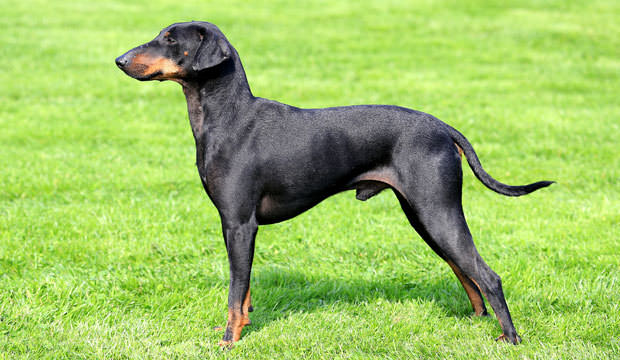
This relatively small dog has bundles of energy and usually enjoys good health. You can enjoy the company of this dog for around 15 years on average.
Although, like all dogs, this terrier enjoys its food, you should avoid overfeeding. Just one quarter to one whole cup of dried food per day should satisfy this dog, depending on the dog’s age, size and activity level.
Feeding your Manchester Terrier up with tasty treats could lead to obesity, which results in serious health problems – and big vet’s bills!
Save the money that you could spend on treats and instead give your dog what it really wants, which is simply your loyalty and attention.
As a short-haired dog, the Manchester Terrier doesn’t have complex grooming needs. You can easily brush him yourself at home, without needing to hire a professional dog groomer.
The Manchester Terrier is very clean, for a dog. You won’t have to splash out on odor-neutralizing products to keep your home smelling fresh, as this dog has very little scent.
14. Jack Russell
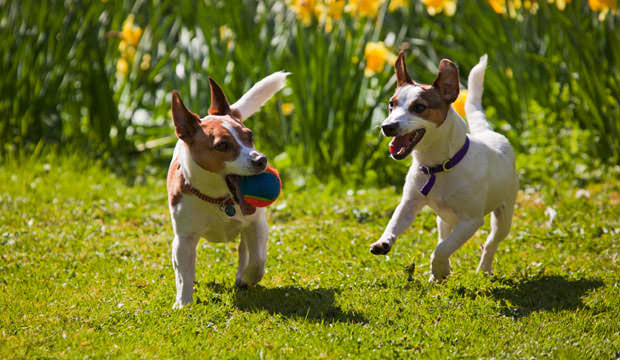
Jack Russell dogs have short hair and generally good health. The bills for the vet and the dog groomer should be pleasantly low.
The one way in which a Jack Russell could cost you a lot of money is in professional dog training.
These stubborn little dogs need strict training to help them to behave appropriately, particularly around children and other pets.
Skip this training for your Jack Russell puppy and you could end up with an aggressive, impatient dog that is difficult to manage.
However, if you have owned dogs before and are confident that you can manage the training, then a Jack Russell can be an inexpensive choice. These are hardy dogs that do not need much pampering.
Jack Russell dogs are usually happiest in homes without young children. This dog needs its own space, or it can become irritable.
If you can offer a calm, loving home for a Jack Russell, then you may be able to find a rescue dog that has already has his shots. This is a cheaper option for getting a new dog compared to buying a puppy from a breeder.
15. Mexican Hairless
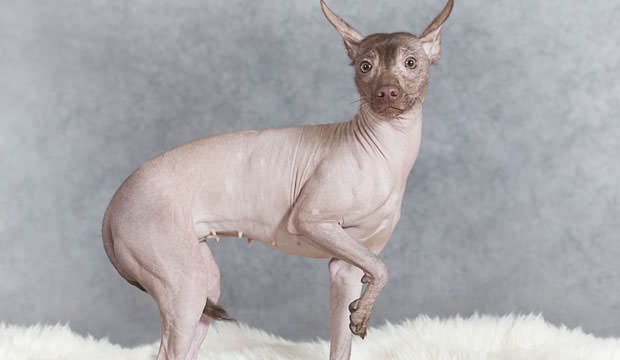
As a hairless dog, this breed has very low grooming requirements. You will not need to brush the dog at all, and he requires infrequent bathing.
The flipside of not having a fur coat is that these dogs are actually quite susceptible to sunburn. Make sure your dog has access to shade if he is spending time outside.
Although these dogs were bred for hunting, their exercise needs are actually quite low. They need between half an hour and an hour of exercise each day, with the exact amount depending on the size and temperament of the dog.
In general, the larger members of this breed tend to be more active and restless. The Mexican Hairless is a good choice for dog owners who are time poor as well as cash poor.
The health costs of this dog are generally low. There are few breed-specific health concerns, with the exception of sunburn due to the lack of a protective fur coat. Limit the exposure that your dog gets to the sun on hot days to prevent this problem.
16. Australian Shepherd
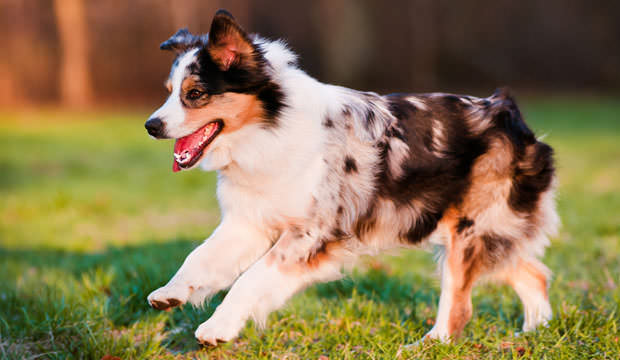
On the other hand, some small breeds need a lot of grooming and other care.
A good compromise is a mid-sized dog such as the Australian Shepherd. This good-natured dog has an attractive mid-length coat and a generally friendly personality.
Don’t worry – even though the coat is beautiful, it does not require much pampering at all. Occasional brushing will keep the coat in good condition, in addition to a bath whenever the dog decides to roll in mud.
The main health problem affecting Australian Shepherd dogs is inherited blindness or deafness. Check the eyesight and hearing of a puppy before you buy to avoid these problems.
This breed of dog is intelligent and usually responds very quickly to training. They are a great first dog for new dog owners as a result.
The Australian Shepherd is not such a good choice if you have no time to exercise it. These dogs are very active and want to get out and about every day. They appreciate having a yard to run around in during the day.
17. Glen of Imaal Terrier
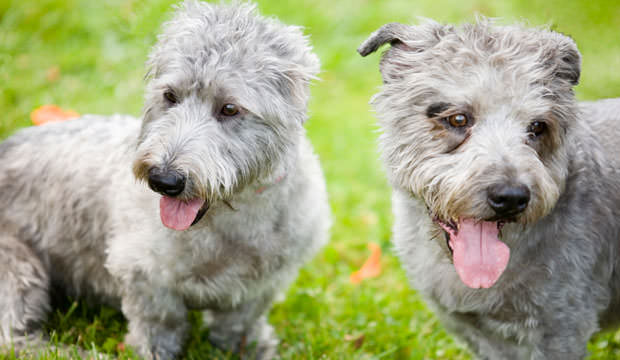
This small breed of dog is happy living in an apartment or a small house. You can expect an adult Glen of Imaal Terrier to weigh up to about 35 pounds. That’s a similar weight to a human toddler.
Thanks to their short legs, they get a lot of exercise just by covering a relatively small distance. Short walks are always appreciated, but this dog isn’t going to demand that you take it out for hours every day.
As you might expect, this small, not too active dog will not eat you out of house and home. Food costs should fit comfortably within your budget.
The Glen of Imaal Terrier breed is more intelligent than many types of dogs. You should be able to train the dog relatively quickly to behave itself around you and your family.
Although this breed does have quite a long coat, the grooming needs are not too high. Brush the coat regularly enough that it does not begin to matt, and you should be able to keep your dog feeling happy. Shedding is minimal with this breed, so at least you won’t have to increase your cleaner’s hours!
18. Rat Terrier
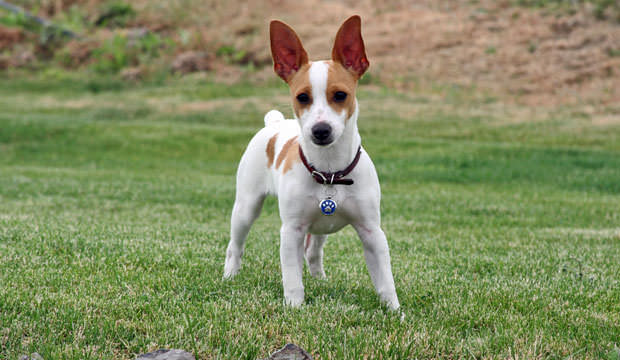
Food costs, healthcare costs, and grooming costs should all be quite low, and this breed is just as happy living in a city apartment as a castle.
The Rat Terrier is a small dog. They weigh less than 25 pounds. There is also a miniature version of the breed that never gets above ten pounds, which is just perfect if you are very short on space.
These dogs are friendly to everyone except rodents! They generally fit very easily into the family with minimal training. You won’t need to pamper this easygoing dog too much to keep him happy, as Rat Terriers are generally very good natured.
Despite having an important job to do, these dogs are notoriously lazy. Your Rat Terrier will be happy lounging around on the sofa with you most of the time.
If you shudder at the thought of a dog sitting on the sofa, calm down! This breed sheds very little thanks to its short, smooth coat.
Best of all, if rodents do move in, your Rat Terrier will be able to sniff them out and take swift action.
19. Cane Corso
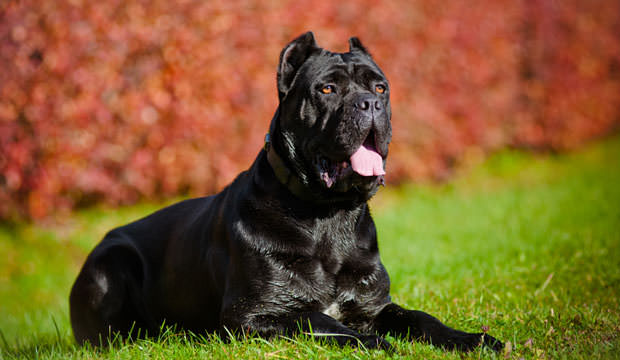
Thanks to its short coat, grooming is very easy with this dog. Expect minimal shedding and a not so demanding grooming schedule.
The Cane Corso is intelligent and fairly easy to train as a result. Unless you’re doing something very wrong, this is not a dog that will force you to pay out for years of training classes and still not understand a basic command by the end of it.
This breed of dog also tends to be fairly quiet, so you don’t need to live in a big detached house to avoid annoying your neighbors!
Cane Corso dogs are generally pretty docile and affectionate, so they cope well with being around children.
These dogs live for around ten years, so make sure you can meet the financial commitments of dog ownership throughout that time before you take on a puppy.
To see whether you can afford to own a dog, work out whether expenses such as buying a house or having a child are likely to feature in your future. Can your budget stretch to accommodate these life events and still have space for chew toys and vet’s bills?
20. Maltese
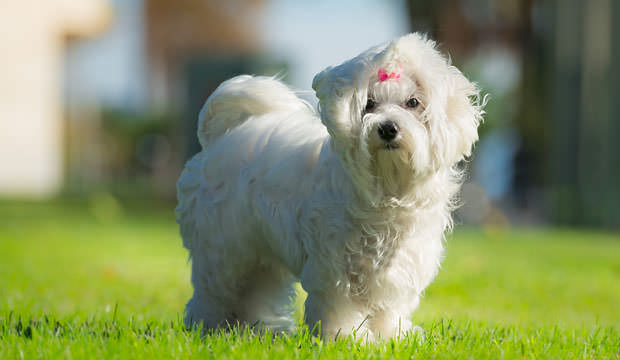
You might think that the long white coat of the Maltese would add to its upkeep costs. However, the coat sheds very little, so you don’t have to increase your cleaner’s hours to keep up with this dog.
One of the great things about the Maltese is that it is very small, only about 5 lbs in weight. It has a similarly small appetite.
As long as it has your attention, the Maltese breed is happy in a small space like an apartment.
These dogs love to be brushed. You can either keep their coats long and straight, or clip it in an inch-long puppy cut for easy maintenance.
Although it’s a small dog, the Maltese has a life span of around 12-15 years. Make sure you are up for the commitment if you are taking on a puppy. Alternatively, you could give a loving home to an older dog that needs a new owner.
Although these dogs are very cheap to keep, the upfront cost will vary widely according to the breeder that you use. Consider adopting a rescue dog instead to keep the upfront cost low.
21. Boston Terrier
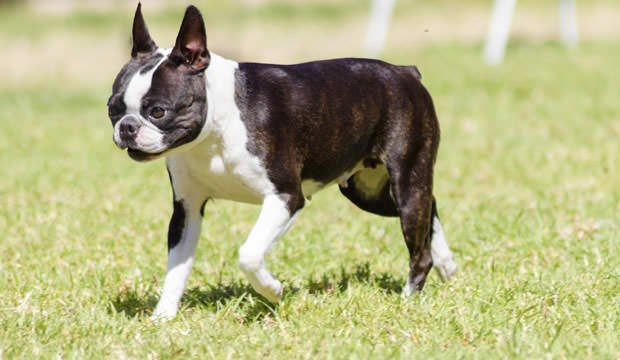
These dogs have short hair and low grooming needs. Brush it every once it a while to remove loose hair and prevent it from shedding in your house.
Worried about whether you have space for this dog? Their weight can vary between 10 pounds and 25 pounds. They like being around people and children, and can even get along well with other pets.
The Boston Terrier was originally bred for fighting, but its gentle temperament is more suited to loving you and your family! You should have no problems training this dog.
There is just one trait that you should know about when dealing with this dog. They like to chew. Not just their food but anything that is left lying around. If you don’t want to spend money replacing your shoes every month or so, invest in some chew toys for your Boston Terrier to enjoy.
It’s a good idea to get all dogs spayed or neutered, but with the Boston Terrier it is particularly important to get this procedure done. These dogs often have trouble giving birth naturally and usually require a caesarian section, which can be expensive.
They also tend to snore, so you might not want this dog to sleep on your bed with you.
22. Miniature Schnauzer
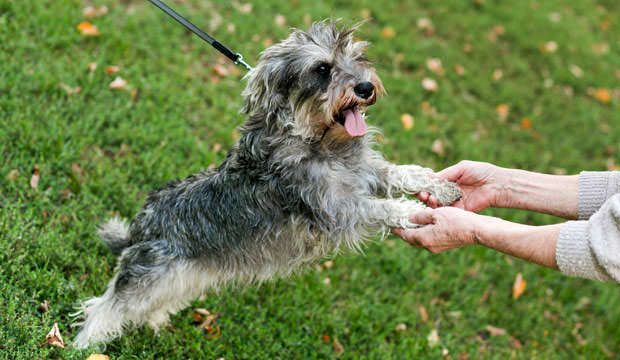
To save on grooming time and costs, keep the Miniature Schnauzer’s coat clipped short. The characteristic beard can be kept long.
Schnauzers usually live for a little more than 12 years, on average. However, you could end up looking after one of these dogs for more than 15 years, so be prepared.
The best option is to adopt one of these dogs if you can, rather than buying a puppy. Rescue dogs are usually much cheaper than puppies.
Miniature Schnauzers come in several different colors: white, salt and pepper, black and silver, and pure black.
These dogs are friendly, intelligent, and eager to please. Training should be a breeze with a Miniature Schnauzer. There is just one thing to note about these dogs, which is that they don’t always get along well with non-canine pets. This breed probably is not the best choice if you already have a cat.
Whatever type of dog you decide to invite into your family, make sure you work out how much time and money you can afford to spend on it before you go ahead and get the dog.

you dont need to go to a breeder to get a purebreed. go to any pound. they are there and being killed daily due to no homes or lack of fosters.
Pound dogs are usually happy to just have someone to love and take care of them. They make great family members. I’ve learned from experience.
We got our “used” Pug from a breeder who was no longer breeding dogs. They had her spayed and gave her to us. We love our “Pugsley”.
Well the Chihuahua i agree. We had one that lived for 14 years and never had one health issue. Now it did get sick and the vet suggested due to her age and cost of the procedure it was probably be better she be put down. No, they dont require 50lb bag of foods every month but you be surprised how much the little 7lb dog can eat.
Did your Chihuahua bark a lot?
I have two Chihuahuas both female and have only heard them bark once, when my son unlocked the door and came in. Had a service man in my house all day and he didn’t even know I had a dog let alone two.
There is a condition or syndrome called “Little dog syndrome”, meaning that the humans give in, give in, give in, to whatever the dog wants because he’s little and cute, and end up with an out of control, spoiled, yappy, sometimes snapping and biting, little dog who knows no boundaries!!! If you can manage to prevent THAT, then the small dogs will work for you, otherwise, don’t get one!!! Its awful to see an entire family being under the thumb (so to speak) of a tiny dog!!!
That happens often with older dogs when they require surgery. When they reach a certain age, the hardships that come with surgery just get to be too much for them and the benefits of the surgery are often not worth the recovery process. I am very glad you got 14 years with your Chihuahua 🙂
Any dog that costs $75.00 didn’t come from a reputable breeder.
RESCUE RESCUE RESCUE… Adopt don’t shop!
I adopted my little Beau from the Rescue when my Katie passed away. I love him so much. They are both Sh It zu’s but Beau has Maltese in him also. They both are very smart and like kids they come with their own personality. I think when they are rescued that they also know what it is to not have a good home and this little guy is the most loving and playful little kid. They have to be groomed each day and go to the beauty shop about every 5 weeks for grooming. They both have been the… Read more »
I own a Havanese Bichon, and as much as love him, they are difficult to house train and can cause a great deal of damage to a home. They also aren’t really lap dogs either.They don’t like to be held, but enjoy it when you pet them. They enjoy spending all day with you, but they keep a distance from you. And he hates rides in a car. – I would prefer a more intelligent breed, that’s more affectionate and better at house training next time around. Further, their coat is very difficult to maintain unless you know a reasonable… Read more »
Wow, I’m so sorry about your experience with your Havanese. I wonder about the breeder. My experience with my two Havanese has been the exact opposite. One boy, one girl, they are both super smart, intuitive, affectionate and sweet. They both house trained in about 4days, are absolute lapdogs and love to be with me at all times. They are very sensitive however so in training them I had to keep that in mind. But, like your Havanese, neither likes car rides. I always recommend the Havanese to anyone wondering what breed to choose as a small furry companion.
I dont see Doxies. Mine is 13 and is the best behaved lowest health issue dog I have ever had… just make a few concessions like a few ramps in the house (like to get onto the bed). Loyal playful very intelligent. and I got her for free from a friend of a friend…. adopt first!!!
Doxies (Dachshunds) can easily slip a disc in their back….very common among that breed, and can’t be predicted or prevented……their LONG backs, bred that way by humans, are TOO long and therefore trouble can come from it…..my uncle’s Doxie had to be put down when he ruptured a disc in his back…not that unusual….
If budget is that much of an issue, then you should not be getting a dog. I’ve seen countless pets suffer needlessly and sometimes even die, because owners could not afford to pay for preventatives or treatments. If you truly love an animal, you won’t force it to suffer just because you can’t afford to provide the things it needs.
I agree. You don’t need to be wealthy to own a dog but you should be able to provide routine care and maintenance as well as have a way to pay for an emergency. E-vets are NOT cheap! Things happen even to the most well cared for dogs. Elderly dogs also after cost more due to disease or other ailments old age can bring.
THAT should be common sense for anyone…..dogs/ cats/ any pets CAN cost money…..invest in pet insurance, or have a “stash” of money for emergencies….twice I’ve had to pay $2000. for surgeries for pets….Once a cat had an middle ear tumor which we didn’t know if it was cancer until it was removed (it wasn’t!!!); and once our Golden Retriever managed to tear almost every ligament in his knee, which required major surgery……but when you love them, you do what you’ve gotta do!!! However for a pet with cancer (and I’ve had two of those as well) I don’t believe in… Read more »
Spent plenty of money on tests making sure his illness wasn’t temporary. Then had him put down while I held him because he was no longer eating or drinking and couldn’t understand why he felt so bad.
The fact that you didn’t put your animals through that misery shows how much you truly loved them. I wish everyone could see that. You have very lucky pets.
But, dogs and cats can often live up to 20 years….you can’t always PREDICT what your income level or job security will be 20 years in the future….thats a dumb way, imo, to decide to get a dog or cat, that is, worrying if in 15-20 years you won’t have enough money to do some major medical procedure on the animal!!! Pet insurance is growing in popularity, and though I haven’t ever tried it, some people swear by it…..I figure if I have enough to feed them high quality food, to take them to the vet for their yearly checkup… Read more »
Where’s the Labrador Retriever? I’ve had 3 Labradors in the past and they didn’t cost much.
Labs and Golden Retrievers (cousins to speak) are both retriever type dogs, not hunting dogs, they would swim out and retrieve the duck or whatever the hunter had shot, and bring it to him…..they both have “soft” mouths, meaning they can carry things in their mouths without any damage to it….. Labs are notorious for a VERY long puppyhood, up to 2 years….Goldens not so much….our Golden was an adult by a year or so…..calmed down, quit chewing things like table and chair legs, etc!!! He was the GREATEST dog we ever had, just a fantastic, gentle, loving, playful big… Read more »
My lab is a cross her father was a purebred yellow lab and her mother a purebred golden retriever. Yes the puppyhood is long she’s only 1 1/2 but she is the best dog we have ever had . She’s so easy going good temperament and absolutely the biggest “suckie baby”. The hips are a huge concern for me as she gets older. All I can say is we keep her at a good weight give her regular exercise and regular vet visits for shots etc. Other than regular costs and a few chewed items l personally think she is… Read more »
You are lucky. A lot of people have experienced health problems and labs tend to eat everything.
Also, puggles are not low energy. At least mine isn’t (and he’s old!). Whenever I run into other puggle owners, the first thing we do is marvel at how energetic and strong they are. They will wear you out. I adopted my puggle from the animal shelter btw.
Gotta love Beagles.
I have a bullmastiff and besides being a great friend, he provides me and my wife a great deal of peace of mind. He lives in the house with us and he probably provides more security than anything ADT could. Most people intent on robbing or hurting someone do a little homework. Only a small percentage decide to wing it. Doing the slightest bit of casing would inform any would be monster that my big ball of fur is a constant presence INSIDE with us and they will have to deal with him if they make that mistake of coming… Read more »
Unless your dog has hundreds of hours of training to be a guard animal I wouldn’t put that much trust in that. Thousands of homes get broken into with dogs in them daily and the crooks don’t get their legs bit off… most times the people just play with the big scary dog or feed him and they leave them alone while they loot your house…. how do I know this 8 had my house broken into and thought the same thing my big scary pitbull was going to eat someone if they came in… but I was really really… Read more »
The best dog I ever had was a Benji type mixed breed that I adopted from the local shelter. For some reason, these mixed breeds don’t seem to get sick. He had an annual check-up and lived to be almost 18 years old.
Mixed breeds, ask ANY vet, are always healthier than purebreds, which tend to be inbred far too much!!!
What was left out of the mix discussion about beagles is that they are very barky. We go to the dog part regularly with our brood and beagles are one of the most popular breeds there. Lord only know how their owners stand it. So if all else is good, you would be happier if you wear a hearing device that you can turn off whey you want to. And I agree with Brittany, you can’t begin to call dogs budget friendly. One thing to keep in mind is that every breed has its own health issues, but cancer is… Read more »
Obviously, I can’t speak for all hound owners but I have a Bluetick Coonhound. Imagine the little bawl of the Beagle being magnified to fit the vocal equipment of a 60-90 lb dog. Other dogs run from my guy the first time he bawls in their face and people have described it as getting “a foghorn blast to the face”. However, despite the vocal tendencies of hounds, they CAN be taught that there is a time and a place. When we go out to play, I let him howl to his heart’s content. However, he knows that, unless WE are… Read more »
yes, beagles howl and bark…..a LOT!!! They’re also known for running away….not that they’re running AWAY from you, but they’re running for the fun and excitement of it…..!
Our Beagles sheds like crazy and his hair sticks into everything and isn’t easily vacuumed out. Socks go thru the washer and drier and still come out with hairs in them. Never seen anything like it! The howling and barking….YES! They must be on a lead at all times. They are VERY smart though! Can learn tricks quickly. Also house trained easily too!
My beagle rarely barks. Only if he sees/smells a small animal or if he’s in guard-dog mode.
The Heart Wants What The Heart Wants.
My jaw dropped when I saw the Bulldog on this list. I have friends with Bulldogs and, despite how much they adore their dogs, they are thinking about going with another, healthier breed in the future. I am very sorry your Bulldog is no longer with you. I’m facing old age with my Smooth Collie (11 years next month) so a loss is coming my way although hopefully not for a couple of years at least. I am very glad you loved your dog despite the cost of caring for the breed. I’ve never owned one but the ones I… Read more »
Right, me too!!! Bulldogs because of how breeding for “looks” by humans has changed them, makes it hard for them to breathe if they are exercised, or just in hot weather…..they puppies HAVE to be delivered by C/Section because the puppy’s heads are too big to pass down the birth canal……they have a LOT of health issues, most related to how they’ve been “changed” to look like they do!!! I’d avoid one, and get almost any other breed first!!!
English/Staffordshire Bull Terrier are amazing pets.
EXCEPT if you live where there is BSL (Breed Specific Legislation, like NO PIT BULLS) you could be in trouble as most people judge what is a Pit bull by its looks alone, and your dog would be constantly confused with a Pit bull!!!
Living in the UK, I believe that isn’t too much of an issue here. At least around London (Live about 30 miles from there)
Correct me if I’m wrong on that. I know some animals are under BSL but I doubt this breed is. I know they’re under higher scrutiny for this though due to high profile cases. Sadly.
I have to disagree on Bichon Frise as a low budget easy to maintain breed. I have found them very difficult to train – particularly to housebreak. They can easily become very destructive. They also have a poodle-type coat that just keeps growing and needs to be cut. Most people are not equipped to trim their own dogs, thus a professional groomer is needed at least monthly.
I have a half Bichon/ half Poodle, and yes, their hair DOES continue to grow, like a humans, so instead of shedding, either you learn to groom it (not that hard!!) or take it to a professional every 3-4 months……the UP SIDE of no shedding is, of course, NO SHEDDING….which is great for households with asthmatic/ allergic members….and is the reason why we’ve mainly gotten poodles/ poodle mixes for many years!!!!
I have had NO issues in housebreaking or training these dogs, or in their being destructive (once past puppyhood!!)
how fortunate for you that your dogs have been trainable and house-breakable. I imagine my parents’ dogs might have responded better had they been better at training, however in talking to people who know the breed, including breeders, they do seem to have a reputation for being difficult. I think a lot of that is that their owners think they are so cute they do not treat them like dogs. I agree that combing them out is not difficult. I do think that getting the cut right is a little tricky – I’ve seen it done badly enough times that… Read more »
I have a pit bull the smartest dog I have ever had. I think it’s
so rude of people to think these animals are killers, it just isn’t true.
I have had many animals, Henri our pit is the most loving, smart animals…
We have a long hair Chihuahua that is now 16 years old. Very affectionate and loving.
Sometimes adoption is to pricy and you don’t get to meet the pups parents so I understand when someone wants a breeder
not Bishons i have one hes a mess
I own a Bichon Frise and have known previous owners who have spent an arm and leg to keep them healthy. This breed can be extremely sensitive to gluten and grains in their food, which adds to their developing skin problems that need a vet’s immediate attention. They are allergic to many types of grasses, causing chronic sneezing and intermittent sinus infections. Their teeth can rot very quickly if you do not have their teeth cleaned on a regular basis. I have learned from others’ experiences and have taken care of my friend’s Bichon for several years. My recommendations: Even… Read more »
I like what this article mentions about some dogs requiring a lot of maintenance but little exercise while other dogs don’t need much maintenance but should be exercised a lot. I think getting a dog that can go with me on runs but that doesn’t need constant grooming could be a good option for me. I’ll have to keep this in mind when looking to buy my first dog.